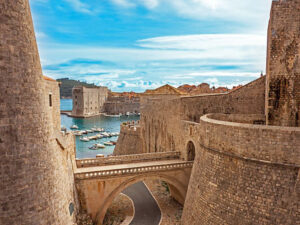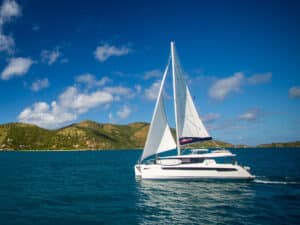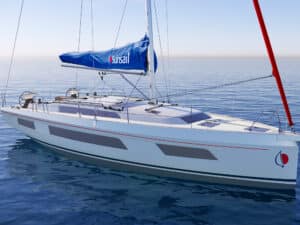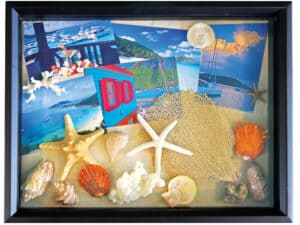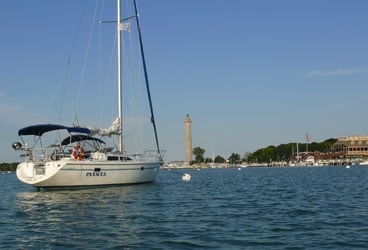
Lake Erie 368
“I’m ready to get into the water,” says Katie Lovett, fellow crewmate aboard Panacea, the Catalina 36 Mark II we’ve taken out from Sandusky, Ohio, for a four-day bareboat charter in the islands of western Lake Erie.
“OK,” says her brother, Mike. “I’ll go on snake watch.”
Katie takes a dip into the lake’s cool, refreshing waters at Manila Bay, at the southwest corner of North Bass Island. It’s an idyllic anchorage. We’ve got the place to ourselves, and we’re surrounded by emerald foliage.
Cottonwoods are in bloom, releasing dainty, miniature tufts of puffy white as far as the eye can see. Fair and gentle breezes blow from the east. Human-made sound other than ours is absent for miles, making the late-spring chorus of song from migrating birds resting at this major North American flyway nearly overwhelming. The sun is shining bright; clouds barely smear the sky.
At this point in a near-perfect mid-June day on Lake Erie-Lake Erie, that unfortunate 1970s metaphor for all that can go wrong in an industrialized society-a perfect foil arrives on cue. It pokes its cobra-shaped, but relatively harmless, reptilian head out of the water and slithers silently within six inches of Katie.
She shrieks. Suds and shampoo fly everywhere. She’s up the swim ladder in a jiff, and she still needs to rinse off.
And she will, by dropping back into the lake. For the plain truth is that Katie and Mike, a colleague of mine who’s an associate editor at CW’s sister publication, Sailing World, love everything about the lake. It’s here, in these islands and in Cleveland, where they and their parents lived and sailed, that they spent their childhoods swimming and racing and getting into mischief.
So they’re eager to show me that the polluted Lake Erie that I’d heard about as a kid growing up north of Pittsburgh isn’t the Lake Erie they know. After all, this, the shallowest, most southern, warmest, and most nutrient-rich of all the Great Lakes, supplies more fish for human consumption than any of the other four combined; it’s the largest freshwater commercial fishery in the world.
It’s a case of what researcher Jeffrey Reuter, the director of Ohio State University’s Stone Laboratory, a biological field station devoted to the study of the lake, describes as the “50 and 2 rule.”
“Lake Erie has 2 percent of the water and 50 percent of the fish,” he says. “Lake Superior has 50 percent of the water and 2 percent of the fish.”
All this good news of environmental viability includes an increasingly thriving habitat for freshwater snakes. The smallish, slender serpent, whose brethren we’d encounter aplenty while we sailed, isn’t a symbol of temptation, evil, or foul waters. The Lake Erie water snake is a sign of health, of rebound, of restoration; it’s evidence that humans can indeed save what they once nearly wrecked for all of time to come.
Indeed, Ohio tourist promoters for the Lake Erie Shores and Islands (www.shoresandislands.com) might bristle at the snakes’ rightful place in regional history, preferring instead to focus on the attractions, manmade and natural, of a key U.S. domestic summer-recreation area, known as much for the splendors of its abundant woodlands as it is for amusement parks and recreational fishing grounds.
But Thomas H. Langlois, of the Department of Zoology and Entomology at Ohio State University, hastens to dole out perspective in Amphibians and Reptiles of the Erie Islands. “Near the western end of Lake Erie, there is a series of islands which were so notable for their snakes when the Jesuit explorer Bonnecampe visited the region on October 5, 1749, that he referred to them as ‘Les Iles aux Serpentes’ (the islands of snakes),” Langlois notes in the academic text.
These features were undoubtedly observed before development, habitat destruction, and human persecution-that’s biologist terminology-caused the water snake to gain federal status as a threatened species and classification by the state of Ohio as an endangered species.
Origins of a Charter
Such is the type of knowledge you gain when you bushwhack into new chartering territory. I’ll point out here that snakes never entered into the conversation when Dave Bello of Fair Wind Yacht Charters told me he was eager to get me sailing on the lake. At boat shows, I’d stop by his booth to chat, and he’d put forth an invitation, oft repeated, to explore the islands on a bareboat.
When I told colleague Mike that Dave’s offer was legit and we could have a boat for a few days, his ears went up. After all, he’d raced Thistles, the one-design that owes its creation to Gordon “Sandy” Douglass of nearby Vermillion, Ohio. And he’d cruised here with his parents aboard Senese, a 42-foot Matthews motoryacht lovingly restored and maintained by his father.
But bareboat chartering? Like the stuff sailors do in the Caribbean? “Never heard of it on the lake,” Mike said. “It’s just not done. This area is definitely not known as a charter wonderland.”
Well, things change, right? The next thing I knew, there we were, on the Ohio coast, sitting in Panacea’s cockpit at a slip at Battery Park Marina in Sandusky. We’d soon be at it full on, vigorously reaching in 10 to15 knots against a backdrop of clean, bustling harbors, numerous pubs and restaurants, secluded anchorages, and solitary walking trails in island woods. Last, but certainly not least, we’d check out the world-renowned Cedar Point amusement park, which boasts no fewer than 17 heart-pumping roller coasters. I couldn’t have picked better cohorts in this adventure.
Before we got to all that, though, we needed Dave’s primer on our boat, with its four and a half feet of shoal draft, and on Lake Erie’s western basin, a recreational playground that’s a bit removed from the deeper central and eastern basins, where most commercial shipping traffic moves.
In a nutshell, Dave told of easy, line-of-sight navigation augmented by well-maintained aids to navigation; we’d be in 20 to 40 feet of water and could expect a generous mix of anchoring, mooring, and raft-up opportunities, depending on the destination. The islands are a mix of public and private, natural and manmade, and U.S. and Canadian; the lake’s largest island, Pelee, is part of Canada, and the largest U.S. island is Kelleys.
In the spring and early summer, prevailing winds are westerlies in the range of 5 to 15 knots, Dave said. From August through winter, they steadily pick up. The water stays warm through November, reaching a midsummer high in the 80s F. If the wind is up or conditions turn foul, the wave pattern is short, steep, and choppy, making waves as formidable as any of the 25-foot seas that Dave’s experienced on his numerous deliveries offshore and up and down the U.S. East Coast, taking boats to Fair Wind’s other teaching and chartering locations in the Chesapeake and the British Virgin Islands.
He teased me about the years-old misperceptions I carried around about a place that on this day was new to me, and he joked about the water snakes and the mighty rides of Cedar Point: “The newest roller coaster goes from zero to 90 mph in three and a half seconds!” He was jubilant; I just looked past him warily toward Cedar Point, whose tall rides I could see in the distance from the marina. As for the snakes, having not yet left the dock, I half listened to him and assumed he was making it up to scare me.
He ended his chart briefing on point: “Great Lakes bottom holding is great, better than the sand of the Caribbean and the mud of the Chesapeake, and the anchor comes up easily,” he said, adding with pride: “This is kind of the spot.”
Well! We quickly weighed our options and pointed our bow north, after a provisioning run to a nearby supermarket-provisioning is way too easy here-and a passing rain shower. A late setting sun meant that we had lots of daylight with which to work, so heading out into Sandusky Bay at 1900 to a nearby anchorage wasn’t a problem.
Off to the Islands
After an hour’s motorsail north in faint wind, we rafted up alongside a power cruiser at the Kelleys Island Seaway Marina, and by dark we were installed at the Village Pump, hearing tales from part-time resident Mike Brown about how the lake freezes over in winter, ferries from the mainland shut down, and a few of the brave 300 souls who live on the island year-round take to the ice roads to get back and forth to the mainland. It gave me pause as I hungrily munched on sweet, locally caught perch and walleye.
Early Sunday morning, I sipped strong, fresh coffee in Panacea’s cockpit while I took in the neighborhood, a lively mix of powerboats, sportfishing boats, and sailboats. Nearby was Allen Murphy, of the Ted Irwin-designed Endeavor 32 Kelleys IV, who explained that rafting up presents plenty of opportunities to make new friends, as he’d done during this and previous sailing seasons.
Murph, as he’s known in sailing forums and blogs on the Cruising World website, learned to sail when he was in the Boy Scouts, and it stuck; he went on to race in college and sail dinghies on various lakes. He’s owned a couple of Catalinas, and he keeps Kelleys IV farther east in Erie, Pennsylvania, the boat’s hailing port.
Keeping the boat in Erie means that if he wants to sail to Canada or to the western shore, he has to set aside at least a week’s time or leave the boat at a marina in Ohio and commute back and forth by car for weekend sailing. But that’s fine, as it’s all part of the plan Murph has to one day retire to the liveaboard life. To that end, he’s spread his wings and chartered bareboats in the Florida Keys, the B.V.I., the North Channel of Lake Huron, and in Australia’s Whitsunday islands.
“In general,” Murph said, “most sailors everywhere are quite friendly and wonderful to meet and know, and Lake Erie island sailors are no exception. There’s a variety of fun and sailing to be had throughout the islands, including sails to Canada, and it makes western Lake Erie a terrific cruising ground.”
With those words in mind, we were eager to have a look around, and we left the marina on foot to find some rental bikes. Lean and toned people in breathable fabrics were stretching their legs all over the town center on this sunny Sunday morning, and it didn’t take us long to figure out that this was an outdoor service in worship of the running shoe: We’d stumbled on a big annual occasion, the Kelleys Island Road Race. If they weren’t stretching, people were lining up to watch the big run-and-walk event.
We moved away from the crowds, got the bikes, and rode north, intent on a stop at the beach at Kelleys Island State Park as well as a visit to the Glacial Grooves, a U.S. National Natural Landmark. The limestone bedrock grooves, which are fenced off, are impressive evidence of the southward movement of the ice sheet that covered North America 18,000 years ago. They contain marine fossils that are 350 million to 400 million years old. The Ohio Historical Society proclaims the landmark the largest collection of easily accessible grooves in the world.
As we continued cycling in an easy, flat loop around the island, a landmass of 2,800 acres with an 18-mile shoreline, we followed a dirt road to the beach, where we caught up with summer resident Gretchen Sharkey and her two boys, 5-year-old Daniel and 3-year-old Andrew, who were playing on the sand. Gretchen, who’s a high-school teacher in Cleveland, loves her summer home.
“We use it all but three months of the year,” she said, looking out over the water and adding: “Right here, now, it’s about as good as it gets. I could sit here all day. In Cleveland, we live for the summers.”
And then it happened. In plain sight, a snake poked its head above the shallows, and slithered ashore. “Oh, there’s a second one, boys,” she called to her kids. “Oh! There’s a baby behind it.”
Mike and Katie ran to take pictures; I stood there, stunned. We hadn’t sailed but a few miles north, and evidence abounded that Dave Bello’s fictional snakes were more than a tale.
As the kids and Mike and Katie oogled and danced around the reptilian wonders, Gretchen took it in stride. “If you have a real phobia of snakes,” she said, “I guess this isn’t the best place to be.”
Then she passed on a tip: A woman called the Island Snake Lady conducts a count of the water snakes and writes a column for island newspapers called Ask the Snake Lady. I had to find her.
In real life, the Snake Lady is scientist Kristin Stanford. Like Reutter, she works out of Stone Lab, where she’s a research associate and earning a doctorate in biology, focusing on the water snakes. She’s studied the Lake Erie water snake since 2000, and she’s also in charge of helping the snake population rebound until it can be removed from endangered and threatened lists.
In the late 1990s, a population count estimated that only 1,500 to 2,000 remained. Today, some 12,000 to 15,000 water snakes thrive, feeding off a steady diet of the round goby, an introduced species that’s harmful to the survival of native fish, especially smallmouth bass.
To get at those numbers, Kristin’s mission is multi-faceted and involves tagging and monitoring the population in its habitat. I didn’t ask if it’s brought her fortune, but it’s definitely brought fame: the Discovery Channel’s Dirty Jobs show declared her job to be one of the grubbiest around. “I’ve been bitten thousands of times,” she says. “It’s nothing more than a scratch. Usually I have fresh bites.”
The snakes, which take to the water in search of gobies, aren’t poisonous. “They can’t hurt pets,” she says. “They’re totally harmless. But they’re fairly aggressive if you mess with them. They’re definitely not shy. If you leave them alone, they’ll leave you alone.”
Mind the Mean Streak
Mystery solved, our crew was free to continue its exploration of Les Iles aux Serpentes. All credit for our masterful itinerary goes to Mike. Relying on past good times and local sailing knowledge, he’d put together a leisurely plan that gave us the Saturday overnight at Kelleys, then a leisurely close reach in steady winds of about 12 knots the next afternoon to South Bass, where we took a mooring for two nights.
At this island, which is celebrated for the parties held in the main town, Put-in-Bay, getting a mooring was a more easily attained goal after the weekend crowds departed. From a mooring in a field populated by Island Packets and such classic plastics as the Pearson Vanguard, we had easy access to town, where we played tourists via rented bikes and saw a few of South Bass’ many attractions, including an ascent up through the Perry’s Victory and International Peace Memorial, the third-tallest monument in the United States.
Our last sailing day, Tuesday, still gave us plenty of time to fit in some exploration of South Bass, an island that, to my mind, with its Lighthouse milkshakes and Lakeside soda, called up memories of Martha’s Vineyard, the island seven miles off the coast of Massachusetts where I’d lived and worked decades ago. By afternoon, we bid farewell to Put-in-Bay and set out on a vigorous reach to Cedar Point.
“We pretty much need to head for the Mean Streak,” Captain Lovett called out to me, at the helm. That a roller coaster can double as a waypoint struck me as part of the charm of the place.
With that as my beacon, we sailed on, past the south shore of Kelleys, over the top of the Marblehead Peninsula and its lighthouse, and south to Cedar Point, which isn’t far from the Fair Wind base at Sandusky.
Upon arrival amid the din and hiss of the high-speed rides and the smells of fried dough and popcorn, we first tended to the boat chores of filling up on diesel and emptying out the holding tank. After a quick dinner aboard, we headed to the park entrance.
Having finally-though barely-attained the height requirement for the scariest rides, I proceeded to the wimpiest ones and, no matter what thrill chasers say, came completely in touch again with my inner 8-year-old.
What a night!
By 0630 on Wednesday, we’d returned the boat to the base and cleaned up. While we tidied up Panacea, I reflected on how the charter had been a resounding success: We’d met other sailors, rode bikes, seen the sights, found peace and seclusion, learned some history and something about efforts to restore the lake’s water quality, and hit the bright nighttime lights of one of the most popular amusement parks in the world. And we did it without busting anyone’s budget.
Yet doubts and misconceptions about the cruising ground’s history lingered in this Pittsburgh kid’s mind, so I put the job of final demystification in the hands of Reutter, the scientist who’d been inspired, after growing up alongside the unsightly spectacle of “orange, lumpy water,” to dedicate his life to the lake.
“People don’t realize how beautiful Lake Erie is,” he said. “People have a negative impression that goes back to the 1960s that’s inaccurate. There’s no doubt that in 1969, Lake Erie was the poster child for pollution problems in this country. Today, it’s the best example in the world of how to bring about ecosystem recovery.”
Efforts and studies of the lake are ongoing at Stone Lab, where Reutter serves as director of the Sea Grant Program for OSU and director of the lab itself. “The concern of scientists is that we’re falling back,” Reutter said. “Instead of the lake continuing to improve, it’s going the other way. Are we satisfied? No. Are we concerned about trends? Absolutely.”
And as for the rebound of our reptilian friends, Reutter conceded: “People aren’t going to like the water snakes. Realistically, the snakes are a good thing. They eat round gobies, a nuisance to anglers, and they avoid people. They’re afraid.”
Well, given the documented polluting, persecuting, and persistent ways of humans, they had-no, have-reason to be, I thought. Then I realized that, despite the struggles, despite what I’d heard as a kid, despite what did happen at Lake Erie, it will now always feel like a new and wonderful cruising ground to me.
Elaine Lembo is CW’s deputy editor.

